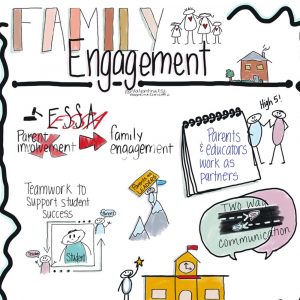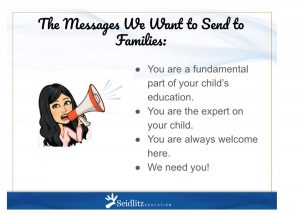Families as Partners: Family Engagement
Authors: Valentina Gonzalez, Educational Consultant and Content Creator, Seidlitz Education
Keywords: family engagement, family outreach, family involvement, interactions, partnerships, relationships, communication, support, student achievement, family voices, shared decision-making

A graphic representation of a variety of words and drawings about family engagement
If it seems that family engagement has become a growing force on your campus or in your district, you may not be mistaken. The push for strengthening family engagement stems from changes that ESSA (Every Student Succeeds Act, 2015) brought forth in education. One change ESSA made was to strike “parental involvement”’ and insert “parent and family engagement.” Not only does this change intend to redefine how we, as educators, interact, but it also redefines who we are interacting with. With this shift, ESSA recognizes that schools and students benefit from the engagement of all family members, not just parents or guardians.
Gone are the days that schools can merely skim the surface with family involvement. Holding typical parent-teacher conferences and open houses to “check the box” will no longer suffice. True family engagement requires schools to create space for families to play an active role in educating students. Within ESSA, parents and families are emphasized as equal partners with educators. In her article Schools and Communities Together, from Harvard Graduate School of Education’s Usable Knowledge, Emily Boudrea asserts that students spend more time outside of school with family and community members who have the potential to make a great impact on learning and success.
Back when we were in school, our parents may have been invited for parent-teacher conferences. They may have brought us up for open house night. And they may even have come to the campus for a play we were in. But other than that and homework help, they likely did little alongside educators to mold our education. Family engagement calls for educators working alongside families in partnership.
What Is Family Engagement?
Family engagement includes relationships between families and schools that promote working together through ongoing communication and culturally responsive support. Family engagement can be described as a two-way street between schools and families. When families are engaged in education, they are not only seen as clients but as partners (Larry Ferlazzo, 2011). When schools actively and intentionally seek to come together with families in an effort to increase student achievement, they lead with a warm, welcoming environment where families’ voices are heard.
How Is Family Engagement Different from Family Involvement?
Family involvement is driven by the school and educators, and families are typically passive members in the process. Some examples of involvement include volunteering at the school, attending open houses, and coming for parent-teacher conferences. In many ways, involvement can be seen as a step toward engagement. We want families to be involved in their child’s education.
Family engagement goes a step further by empowering families to take an active role in their children’s success. These are some characteristics of family engagement:
- Two-way communication
- Intentional outreach
- Joint development of initiatives
- Shared decision making
- Parents as leaders
- Committees that reflect all stakeholders
What Is Outreach?
Think about a time when a friend reached out to help you. Did they reach out with care and comfort? Did you trust them? How did they work to build a relationship either before or during the conversation?
Family outreach is similar in a way to reaching out to a friend in need. We start by building and sustaining positive, supportive, and caring relationships. First and foremost, we want to know our families, their stories, and their needs. When we know our students’ families and their needs, we can truly plan together to create a system that will support their success. Families that feel respected, valued, and heard tend to engage in school more often. Creating open lines of communication as well as platforms such as committees and surveys where parents can share their needs is vital in successful family engagement.
We want families to know that they are valued and respected as part of a team to support the success and growth of their children.

The Messages We Want to Send to Families
What Are Some Guiding Questions to Consider?
- Are families’ voices listened to? If so, how? If not, how can this be improved?
- What platforms are provided for families to be heard?
- How do we ensure that all families are brought “to the table” for engagement?
- What systems are in place to sustain family engagement?
- What involvement or engagement do we already have that’s working well? How can we strengthen it?
References
From “Families as Partners: Family Engagement,” by V. Gonzalez, 2019, Seidlitz Education Blog, (https://seidlitzblog.org/
Gonzalez, V. (n.d.). Serving multilingual learners. Infographics. https://www.valentinaesl.com/infographics.html
